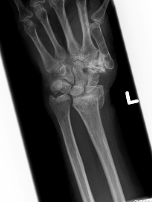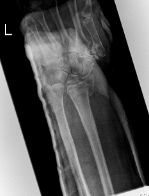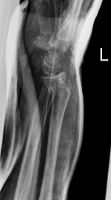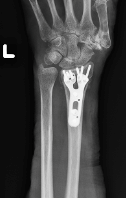Treatment of Distal Radius Fractures Case Study
Distal radius fractures are common and account for a substantial amount of health care dollars¹.There is an estimated incidence of 643,000 per year in the United States². These injuries occur in both young and elderly patients and may result from high-energy injuries, such as motorcycle accidents or low energy injury, such as fall from standing position in an elderly patient with osteoporosis. There is a trend toward operative treatment of these injuries, even for elderly patients who previously were treated without surgery based on the feeling they can function well even when the fracture heals in a malunited position³.
Treatment for these injuries should be based on sound surgical principles and follow the best available evidence to improve patient outcomes. The American Academy of Orthopaedic Surgeons (AAOS) has developed Clinical Practice Guidelines (CPG)4 and Appropriate Use Criteria (AUC)5 for these purposes.
History and Preoperative Evaluation
A 73 year old lady fell while walking her dog, landing on her outstretched left hand, resulting on a notable deformity of her wrist. She was seen at an urgent care, where radiographs were obtained and she was diagnosed with a distal radius fracture, underwent attempted closed reduction and has been sent to the office for further treatment. She is healthy without medical co morbidities and active, participating in recreational sports, including tennis and golf. Upon evaluation three days following he injury, she is noted to have moderate swelling in the fingers, but is able to flex them to the extent of her sugar tongs splint. Her sensation is normal in the distribution of the median, ulnar, and sensory branch of the ulnar nerve. Her initial films demonstrate dorsally displaced fracture with dorsal comminution and radial shortening. Repeat radiographs show an intra-articular fracture of the distal radius and ulnar styloid fracture with radial shortening of 5 mm with an ulnar positive variance.
The AAOS clinical practice guidelines recommend surgical fixation for distal radius fractures with post reduction radial shortening >3mm, dorsal tilt >100, or intra-articular treatment or step-off >2mm (moderate strength). After a discussion with the patient, surgical treatment is planned and performed the following day under regional anesthesia as an outpatient with a fixed angle volar locking plate (treatment as described in AUC) (Figure 1). She is discharged home with instructions on elevation, finger motion, pain medication and instructions to take vitamin D – 1000 units per day and vitamin C – 500 mg per day for six weeks (moderate strength recommendation).
Figure 1 A-E
A. B. C. D. E.





Radiographs of patient with left distal radius fracture. A,B – Initial posterior-anterior and lateral radiographs, C,D – post reduction posterior-anterior demonstrating improvement in alignment, but radial shortening and E– post-operative posterior-anterior and lateral images demonstrating restoration of radial length to preinjury level
Postoperative Care
The patient returns to the office one week following her surgery. Her wound is well approximated and she has minimal discomfort, controlled with acetaminophen. Her post reduction imaging, including a true lateral of the carpus (moderate strength recommendation), demonstrates restoration of radial length, radial inclination, and alignment of the radiocarpal and distal radial ulnar joints. She has a custom orthoplast orthosis fabricated and is given instructions for a home exercise program, focusing on finger motion and progressing to wrist motion and forearm rotation when she is comfortable (moderate recommendation).
References
1. Shauver MJ, Yin H, Banerjee M, Chung KC: Current and future national costs to Medicare for the treatment of distal radius fracture in the elderly. J Hand Surg Am 2011;36(8):1282-1287.
2. Chung KC, Spilson SV: The frequency and epidemiology of hand and forearm fractures in the United States. J Hand Surg Am 2001;26(5):908-915.
3. Chung KC, Shauver MJ, Birkmeyer JD: Trends in the United States in the
treatment of distal radial fractures in the elderly. J Bone Joint Surg Am 2009;91(8):1868-1873.
4. Lichtman DM, Bindra RR, Boyer MI et al. Treatment of Distal Radius Fractures: AAOS Clinical Practice Guideline Summary. J Am Acad Orthop Surg 2010;18:180-189.
5. Murray J, Gross L. Treatment of Distal Radius Fractures: AAOS Appropriate Use Criteria Summary. J Am Acad Orthop Surg 2013;21: 502-505.
